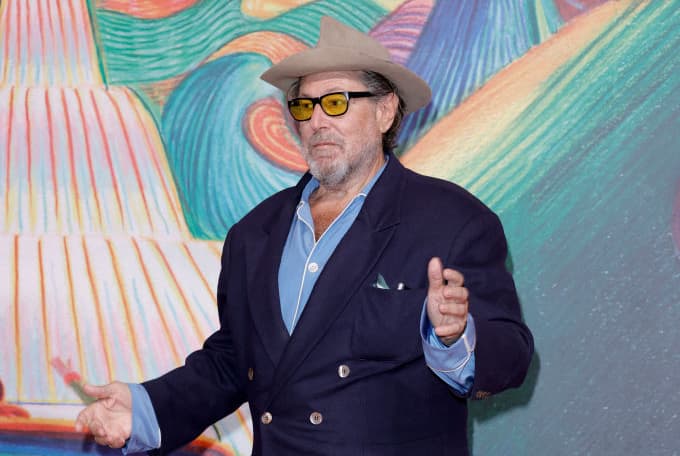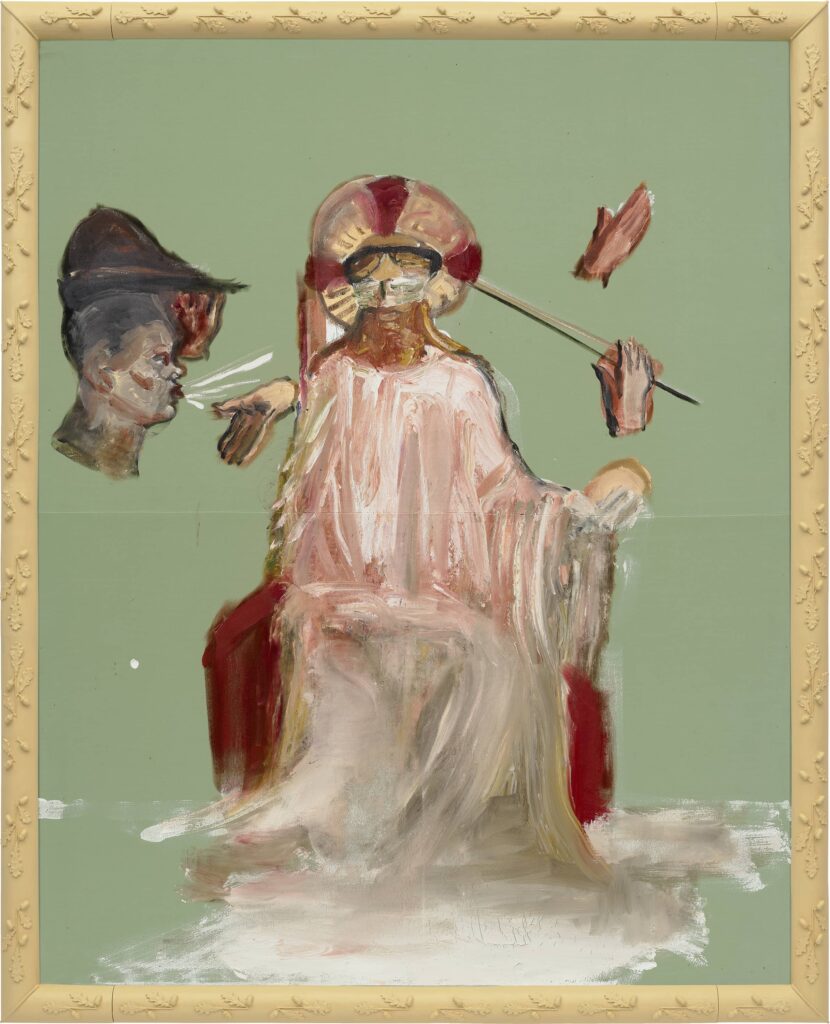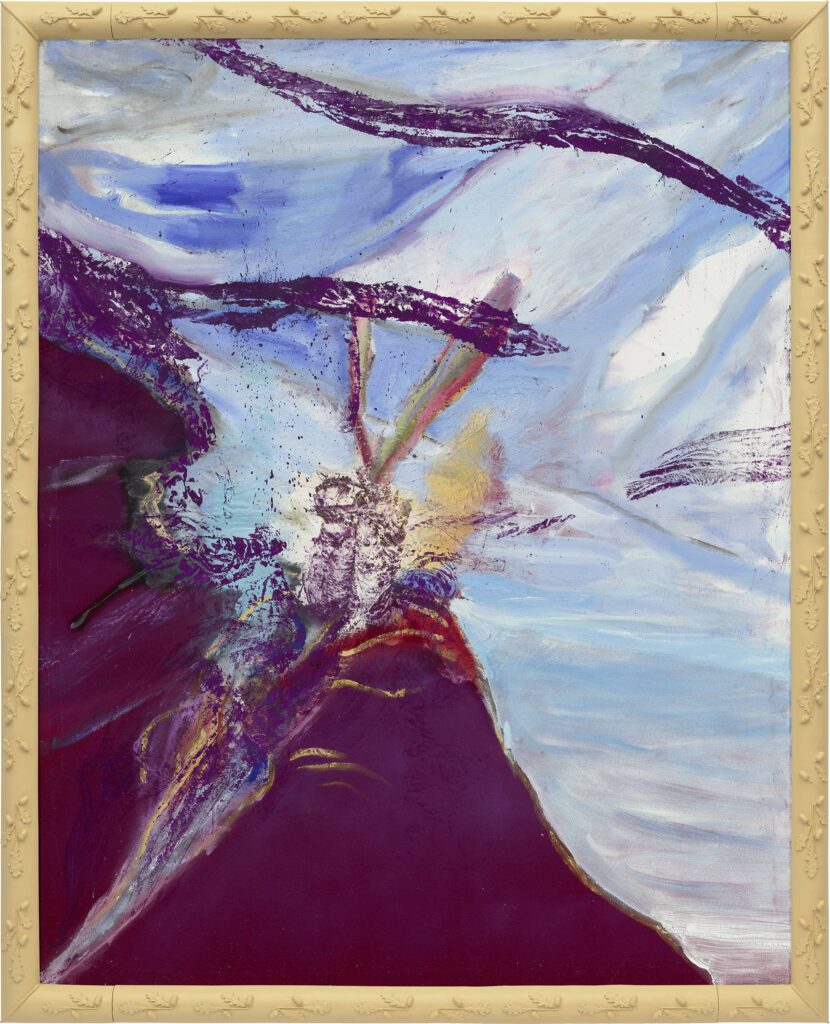Julian Schnabel, Channeling Dante, Ventures Into the ‘Illimitable’ in a ‘Bouquet of Mistakes’ at Pace
Eleven large velvet works delve mostly into the artist’s current film project, an adaptation of Nick Tosches’s hard-boiled historical novel ‘In The Hand Of Dante.’

Julian Schnabel: ‘Bouquet of Mistakes’
Pace Gallery, 540 West 25th Street, New York, NY
Through October 28, 2023
The enfant terrible of the 1980s art scene, Julian Schnabel, who went on to become an award-winning film maker with “The Diving Bell and the Butterfly” and “Basquiat,” has found a new obsession, and he has it handsomely displayed in his new painting show at Pace. Eleven large velvet works delve mostly into his current film project, his adaptation of Nick Tosches’s hard-boiled historical novel “In The Hand Of Dante.”
Tosches’s novel traces two parallel stories seven hundred years apart. In medieval Italy, Dante Alighieri, exiled from Florence by his political rivals, must spend fifteen years as a nomadic wanderer apart from his family. He slowly turns his bitter exile into a mystical pilgrimage, which eventually allows him to compose his magnum opus.
In the second story, a twenty-first century character named Nick Tosches is called upon to authenticate a handwritten copy of Dante’s poetic masterpiece, stolen by a priest from the bowels of the Vatican library. The workings of a great poetic mind are contrasted with the struggle of a modern man — himself a great lover of poetry and knowledge — to resist the temptations of the squalid underworld.
This is a common theme of Tosches’s work: the tension between low and high, sacred and profane, and the occasional impossibility of telling them apart. It’s no coincidence that these conflicts are in evidence in Mr. Schnabel’s show as well. After all, these are the themes that have powered his entire career.

To wit, Mr. Schnabel’s work has always been marked by an aesthetic of uneasy contrast. His sense of color, composition and balance are exquisitely refined, yet he also flirts with kitsch, irony, and accident in every brush stroke. High and low butt heads in his work, and he relishes the conflict. That this conflict takes center stage in his latest show and newest film seems predestined.
Much of the pictorial content of the show is based on a close reading of Tosches’s symbolism. In the novel, the tower of the Sicilian fort of Trapani appears to Dante as an omen. Seeing it, Dante realizes the purpose of his exile is to “know that for which the Gnostics had been damned.” The tower signifies forbidden knowledge and journeys to spiritual realms that will allow the poet to eventually write his masterpiece.
Six large pictures in the show are devoted to this tower — three dominate the back wall — shown rising from frothy ocean waves. Sequentially numbered, they are all titled “The Nine Skies and the Mountain Fortress.” Dante makes reference to the “nine skies” in Tosches’s novel, saying that they describe the sky at particular times that he is able to uniquely discern. They include a sky of “illimitableness.”
Mr. Schnabel attempts to paint each of these skies with ribbons of rose, fuchsia, cerulean, and yellow, all against the stark outline of the tower. Often, the slashes of color go beyond the artist’s frame, as if wanting to extend the sky past its confines, into the “illimitable.”
Another large work, portraying the mocking of Christ, brings the show’s Christian background in sharp relief. Christ is the cosmological figurehead of both the Divine Comedy and Tosches’s novel, after all. This picture is striking in that Christ is the only intact body in the painting. The mockers appear in disembodied pieces against the pale celadon green background. It brings to mind an early renaissance icon reimagined in fragments, with a nod to Francis Bacon.

Through his use of parallel narrative, Tosches managed to entwine his own story with that of Italy’s greatest poet. In this show, Mr. Schnabel revels in both in a heady mixture of street-tough romanticism and high-flown gnostic aspiration. We can only wonder what the film will bring.
The largest centrepiece of the show, though, is not devoted to the film, but to cinema. It is a series of ten panels dedicated to filmmaker Luis Bunuel and his screenwriter, the novelist Jean-Claude Carrière. Each canvas is its own distinct color of velvet, overlaid with lyrically abstract shapes rendered in oil, spray paint, and molding plaster.
Each is an exercise in virtuosity, but there is a loose and accidental charm to each of them. One of Schnabel’s great virtues, beneath all the grandiosity, is a sense of fun. It summarizes Schnabel’s own artistic philosophy of contrasts: “I am making a synonym for the truth with all its falsehoods, oblique as it is. … A bouquet of mistakes.”

